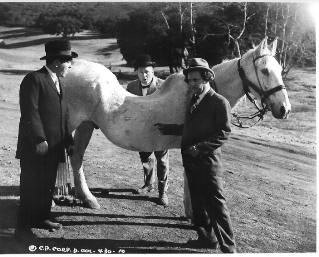Can a Sway Back Horse Be Corrected? Yes, a swayback horse can be corrected with some time and effort. Swayback is caused by an imbalance between the back muscles and those of the abdominal area. The goal of correcting a sway-back horse is to strengthen the core and abdominal muscles while stretching out or releasing tension in the back muscles.
This can be done through regular exercise that includes walking, trotting, lunging and hill work. In addition, massage therapy may be beneficial as it helps to break up any existing muscle adhesions that are causing pain or tightness in the area. Ultimately, proper nutrition is essential for maintaining overall health and musculoskeletal balance; this means providing your horse with adequate amounts of vitamins and minerals along with quality hay/forage sources.
Yes, a swayback horse can be corrected with appropriate exercise and training. Working the horse in long lines to help it keep its balance will strengthen its core muscles and improve its posture. Additionally, stretching exercises can help loosen tight hind-end muscles that are contributing to the swayback condition.
With time and consistent effort, this type of injury or conformational issue can be improved significantly.
How to Fix Sway Back Horse
Swayback is a common postural abnormality seen in horses, and can be caused by poor saddle fit, incorrect riding technique or underlying medical conditions. To help fix sway back horse, it is important to have the correct fitting saddle that matches the horse’s conformation and provides even weight distribution throughout the body. Additionally, having your vet perform an examination to rule out any medical issues that may be causing the issue is also beneficial.
The use of core strengthening exercises can also help improve posture and strengthen weak muscles associated with a swayback. Finally, ensuring proper rider placement in conjunction with appropriate training techniques will enable your horse to carry themselves correctly and reduce strain on their backs.

Can You Reverse Sway Back in Horses?
Yes, it is possible to reverse swayback in horses. The first step is to assess the cause of the sway back. If there are no underlying medical issues causing the swayback, then you can begin a corrective exercise program designed to strengthen and build up your horse’s core muscles.
This can include exercises such as hill work, trot poles, cavaletti, lunging with side reins, or the use of an equine balance ball. Additionally, adjusting your horse’s saddle fit may be necessary if it does not properly support his spine and withers when ridden. Proper nutrition should also be considered when addressing muscle development for reversing a swayback – providing adequate vitamins & minerals as well as sufficient calories for energy needs will help ensure that he has enough fuel to rebuild his core muscles and restore proper posture over time.
With dedication from both rider and horse alike during this rehabilitation process results can be seen quickly!
How Do You Get Rid of a Horse’S Sway Back?
Swayback is a common posture problem in horses, characterized by an exaggerated arching of the horse’s spine. It can be caused by poor conformation or incorrect saddle fit, but it can also develop over time as a result of muscle weakness and imbalance. While there’s no surefire cure for swayback, you can help your horse regain strength and flexibility with proper conditioning.
A comprehensive program should include stretching exercises, therapeutic massage, chiropractic adjustments and regular turnout on level ground or hillsides to help build strong muscles along the length of the spine. You may also want to look into equine therapy products such as supportive back pads and corrective girths that help support the hindquarters while your horse works under saddle.
What Causes a Horse to Become Sway Back?
Sway back in horses is a condition that occurs when the natural curvature of the horse’s spine begins to flatten out, causing a dip or sag between their shoulder blades. This condition can happen for various reasons, but most likely due to poor conformation and weak abdominal muscles. Poor conformation can cause problems with weight distribution across the horse’s body, leading to an uneven skeletal structure and improper posture which puts more strain on certain areas such as the lumbar region.
Weak abdominal muscles also play a role in swayback because they are unable to properly support the vertebral column which then causes it to sag down over time. Other potential factors include obesity, incorrect saddle fit or riding style, degenerative diseases of the spine, old age, and injury or trauma caused by falls or kicks from other horses during exercise. While these conditions may not be preventable in some cases – there are measures that can be taken by owners and riders alike in order to reduce their occurrence including proper nutrition for healthy muscle tone; regular fitness work such as stretching exercises; using high-quality tack that fits correctly; avoiding activities that could put undue stress on your horse’s back; and ensuring adequate rest periods after any strenuous physical activity as well as providing your horse with plenty of turnout opportunities so he/she can move freely without restrictions.
How Do You Fix a Sway Back Posture?
Swayback posture, also known as hyperlordosis or swayback, is a condition in which the spine takes on an exaggerated curve. This can lead to lower back pain, poor posture and spinal misalignment. Fortunately, there are several ways to correct this condition and improve your overall health.
One of the most effective ways to fix a sway-back posture is by strengthening your core muscles with specific exercises designed for this purpose. These may include planks, bird dogs and Superman exercises that target the abdominal muscles as well as those in the lower back. In addition to these exercises, you should focus on proper form when lifting weights or doing other physical activities such as running or biking.
Performing static stretches can also help stretch out tight muscles in the area and relieve pain from spasms due to muscle imbalance caused by improper posture over time. Another important step for correcting a swayback is improving flexibility with stretching routines focused on increasing range of motion throughout your entire body, especially the hamstrings and hip flexors which are often tight in people with this type of posture problem. Yoga poses like Cat/Cow pose can be particularly helpful here since they involve arching backward – an essential movement needed for correcting any postural imbalances causing excessive curvature along your spine.
Additionally, foam rolling before exercise will help reduce tension across affected areas while breaking up adhesions between soft tissues so they may move more freely again without restriction or discomfort during activity or daily life tasks alike!
5 Ways to Strengthen a Swayback Horse
Conclusion
In conclusion, a sway-backed horse can be corrected with the right treatment. With consistent exercise and stretching, along with massage therapy and chiropractic care, you can help your horse to maintain a healthy posture. It is also important to feed your horse a balanced diet that includes plenty of vitamins and minerals for optimal health.
Taking care of your sway-back horse will not only improve their overall comfort but also enhance their performance capabilities in the long run.
Janet G Kulick is an experienced horse rider, trainer, and owner of the informative horse blog, Horseray.com. Her engaging writing style and wealth of knowledge on horse care, riding, and training make her a trusted source for horse enthusiasts worldwide.






